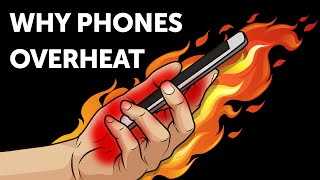
Beat Battery Overheating in 2024: 7 Proven Tips to Keep Your Phone Cool and Efficient :-
- Optimize Settings: Reduce screen brightness, disable unused apps, and turn off features like GPS, Bluetooth, and Wi-Fi when not needed to lower battery strain.
- Avoid Extreme Temperatures: Keep your device out of direct sunlight or cold environments, as extreme temperatures can increase battery heating.
- Use Quality Chargers: Use the original charger or a high-quality one that matches your device’s specifications. Fast chargers can cause heating if not designed for your phone.
- Limit Intensive Tasks: Running heavy apps or games for long periods can overheat the battery. Take breaks to allow the device to cool down.
- Update Software: Ensure your phone’s software is up-to-date, as manufacturers often release updates that optimize battery performance and reduce heating issues.
- Check Battery Health: If your battery is old or damaged, it may overheat more easily. Consider replacing the battery if it’s significantly degraded.
- Use Power-Saving Mode: Activate power-saving modes to reduce the overall strain on the battery, which can help in controlling the temperature

1. Optimize Settings :
To optimize your smartphone’s battery life, you can take several steps to reduce strain on the battery:
Reduce Screen Brightness: The display is one of the biggest power consumers on a smartphone. By lowering the screen brightness, you can significantly decrease the amount of energy it uses. You can adjust this in the settings or enable auto-brightness, which automatically adjusts based on ambient light.
Disable Unused Apps: Many apps continue to run in the background even when you’re not using them, consuming battery power. By closing or disabling apps you don’t frequently use, you can conserve energy. You can do this by accessing your phone’s app settings and manually stopping or disabling these apps.
Turn Off Unnecessary Features: Features like GPS, Bluetooth, and Wi-Fi are useful, but they can drain your battery if left on when not needed. By turning off these features when they aren’t in use, you can extend your battery life. For example, switch off GPS when you don’t need location services, and disable Bluetooth and Wi-Fi if you’re not actively using them.
Taking these steps will help reduce battery strain, allowing your device to last longer between charges.
2. Avoid Extreme Temperatures ;
Extreme temperatures, whether too hot or too cold, can negatively affect your device’s battery. High heat can cause the battery to overheat, reducing its lifespan and efficiency, while extreme cold can temporarily decrease battery performance. Keeping your device away from direct sunlight or cold environments helps maintain optimal battery health.
3 . Use Quality Chargers ;
Using the original charger or a high-quality charger that matches your device’s specifications is crucial for several reasons:
Compatibility: Original chargers are designed specifically for your device, ensuring that the voltage and current are optimal for safe charging. Using a charger that doesn’t match your device’s specifications can result in inefficient charging or, worse, damage to the battery or internal components.
Safety: High-quality chargers are built with safety features like overcharge protection, short-circuit protection, and temperature control. Low-quality chargers might lack these safeguards, increasing the risk of overheating, battery swelling, or even fires.
Performance: Fast chargers are convenient, but they need to be compatible with your phone’s charging technology. If a fast charger isn’t designed for your phone, it can cause the device to heat up excessively, leading to potential long-term damage to the battery or reduced battery life.
In summary, using the correct charger helps maintain the longevity of your device, ensures efficient charging, and reduces the risk of overheating or damage.
4. Limit Intensive Tasks ;
When you run heavy apps or games on your device for an extended period, the processor and other components work harder, generating more heat. This increased activity can lead to the device overheating, particularly the battery. Overheating can cause the battery to degrade faster, reducing its overall lifespan and potentially leading to performance issues.
By taking breaks during intensive tasks, you give the device time to cool down. This cooling period helps to prevent overheating, maintaining the battery’s health and ensuring that your device continues to perform optimally over time. Regular breaks are especially important if you notice the device getting warm to the touch, as it indicates that the internal temperature is rising.
5 . Battery Management Apps ;
Battery management apps are designed to help users optimize the performance of their smartphone’s battery, ensuring it lasts longer and operates efficiently. These apps or built-in features in smartphones monitor the battery’s usage and provide insights into which apps or processes are consuming the most power. By identifying these power-hungry apps, users can make informed decisions to either close or limit their activity.
Moreover, battery management tools often include settings that can help reduce heating issues. For instance, they might allow users to lower the screen brightness, limit background activities, or switch to a power-saving mode that reduces the phone’s overall power consumption. By reducing the strain on the battery, these tools help in managing heat generation, as excessive heat can degrade battery life over time.
In summary, using built-in battery management tools is a practical way to monitor and control battery usage, optimize performance, and minimize overheating, thereby extending the overall lifespan of the battery.
6. Check Battery Health ;
When a battery is old or damaged, its ability to hold and distribute charge effectively diminishes. Over time, this degradation can lead to increased internal resistance, causing the battery to work harder to provide the same amount of power. As a result, the battery generates more heat, especially during activities that demand higher power, such as gaming, streaming, or multitasking.
A degraded battery not only heats up more quickly but also may exhibit other symptoms like shorter battery life, unexpected shutdowns, or slower charging times. Continuing to use a significantly degraded battery can lead to further issues, including potential safety hazards.
To address this, checking the battery health is essential. If the battery health is found to be significantly reduced (usually indicated by a percentage lower than 80% on most smartphones), it is advisable to replace the battery. Doing so can prevent overheating, restore battery life, and improve overall device performance.
7.Use Power-Saving Mode ;
Activating power-saving mode on your smartphone is a practical way to manage and extend battery life, especially when your device is running low on power or during extended periods of use. Here’s how it works in controlling temperature:
- Reduced Performance: Power-saving mode typically lowers the device’s performance by reducing the CPU’s speed, which in turn decreases the amount of heat generated by the processor. Less strain on the CPU means less energy consumption and, consequently, lower temperatures.
- Limited Background Activities: This mode often restricts background activities like app refreshes, location services, and push notifications. By limiting these processes, the device’s workload is reduced, which helps in keeping the temperature down.
- Dimming the Display: Power-saving mode usually reduces the screen brightness or shortens the screen timeout. The display is one of the most power-hungry components, so dimming it significantly reduces battery usage and prevents the device from heating up.
- Disabling High-Energy Features: Features like vibration, GPS, and animations may be disabled or limited in power-saving mode. These features can consume a lot of power and generate heat, so turning them off helps maintain a cooler device temperature.
By managing these various aspects of your smartphone’s operations, power-saving mode effectively controls the temperature, which not only preserves battery life but also protects your device from potential heat-related damage.
Share : facebook.com twitter.com linkedin.com
